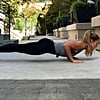

One of my favorite body parts to train is my back. I love looking toned when I wear backless dresses, and I just love the feeling of having a strong upper back. While I really enjoy working on my pull-ups and lat pull-downs on the machine, every once in a while there comes along an exercise that allows me to hit multiple muscle groups at a time, which is why I've recently fallen in love with the renegade row.
The renegade row is a multitasking exercise that tones your back and works your core, while also testing your balance and stability. It's the ultimate functional strength-training move that will give you a huge bang for your buck. I've been working on this exercise with my trainer a lot recently, and it didn't take me long to realize that it's much harder than it looks, especially if you have somebody hovering over you and making sure your hips stay in one line the whole time. Ouch!

Grab a pair of medium dumbbells (or kettlebells, but this will require even more balance and stability), and let's get to work. Here's a step-by-step guide on how to do renegade rows.
- Start in high plank, each hand holding onto a dumbbell that is resting on the floor. Move feet wider than shoulders.
- Pull right elbow back, raising dumbbell toward chest, keeping right elbow close to torso, abs tight, and hips in one line.
- Brace your core the whole time to stabilize your body and protect your lower back.
- Lower weight and repeat on the opposite side. This counts as one rep.
- Do 3 to 4 sets of 10 reps.
You'll notice that it takes a lot of effort to stabilize yourself while you're in this position. Here's a little tip my trainer shared with me: when you're lifting your right arm off the floor with the dumbbell, press your left hand into the dumbbell on the floor. This will give you a little extra strength to keep your hips in one line.
When I was wearing a backless bodysuit last weekend, my husband complimented me on how toned my back looked. It's a body part that we can't see ourselves, so to know that someone else noticed and could tell a difference meant all my hard work was paying off! Give this exercise a try, and see how it works for you.



0 comments :
Post a Comment